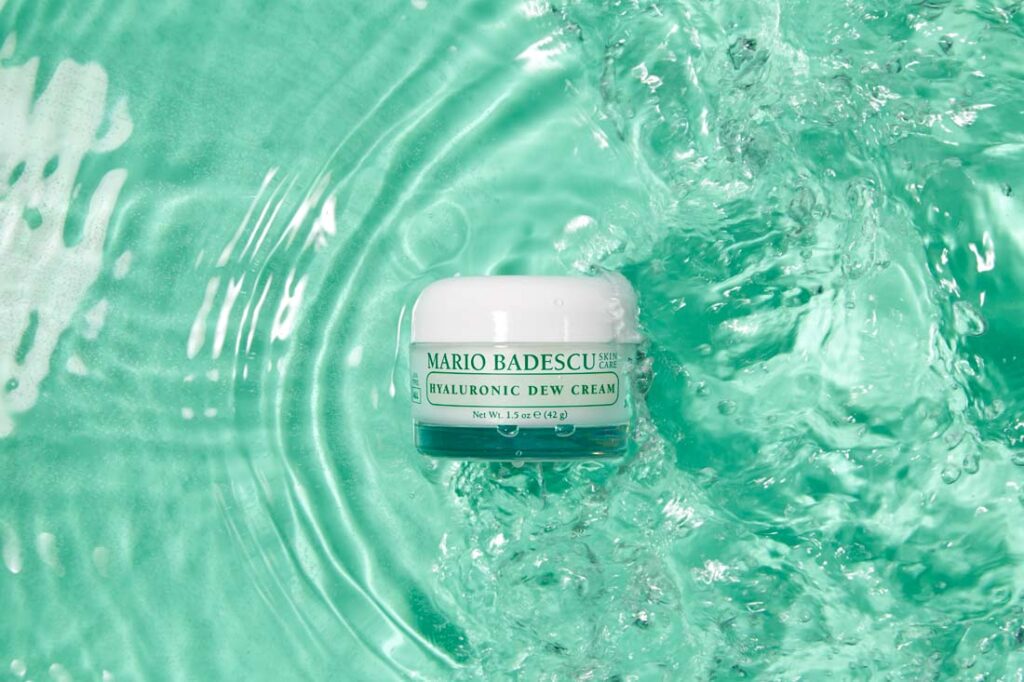On a vacation in Arizona a few years back, as we wandered around in the hot sun and bemoaned the dry air, a friend pulled a small plastic bottle from her bag. “Anyone want a spritz?” she asked, spraying down her face and neck with the contents of the unassuming white-and-green container.
The refreshing substance, I’d soon learn, was Mario Badescu’s Facial Spray with Aloe, Cucumber and Green Tea, and after that first spritz in the Arizona heat, it’s been a staple in my skincare routine. Few facial products have ever insinuated themselves into my life and my medicine cabinet as quickly as this one, a fact I share with Mario Badescu’s president, Joey Cabasso, when we sit down to talk about his timeless skincare brand.
“That’s exactly what we try to do,” he replies, and you can hear the pride that swells in his voice. “We love to hear those stories of word-of-mouth.”
Mario Badescu history
Mario Badescu may be a big name in skincare now, but the brand comes from humble beginnings. Its eponymous founder, an immigrant from Romania, started the company in 1967, giving facials out of a two-room apartment on East 52nd Street in Manhattan.
“He started where we are now, on 52nd Street; we never left,” Cabasso says. It’s true: 55 years later, you can still book a facial at his original Manhattan salon.
Badescu was a chemist and an aesthetician, and as he treated people with an array of different skin concerns, he’d formulate special botanical-based products for them. Eventually, he took over even more space in the building, adding extra salon rooms and hiring more aestheticians to help out.
“That whole time, he was still making his own products,” Cabasso says. “I think he was making [them] in the basement at the time.”
Mario Badescu: from small salon to celebrity skincare
As Badescu’s reputation grew, so too did his list of celebrity clients. Martha Stewart, a longtime proponent of the skincare line, started seeing Badescu for facials during her modeling days in the 1970s. But the pioneering skincare expert passed away in 1983, which is when Cabasso’s father bought the brand.
Cabasso says his dad didn’t know much about skincare at the time, but he thought of the company as an investment, because they could see there was something there that really clicked with people. For about a decade, the Cabasso family was content to let someone else run the Mario Badescu brand, and it quietly chugged along. It wasn’t until 1996 that Joey Cabasso and his brother took over and things really started to take off.
“We saw the potential of who comes, and what celebrities come,” Cabasso explains. “Martha Stewart, Sarah Jessica Parker, Cher, Naomi Campbell, Liv Tyler, Heidi Klum, Jennifer Aniston—all these people were coming in their early careers, and we’re like, ‘Wow. The following is there. Let’s expand the salon.’”
They did, growing into 36 rooms, and continuing, at that time, to manufacture the product in the basement. Things really started to accelerate when they moved into retail, first with the NYC department store Henri Bendel, which led to partnerships with more and more retailers. Eventually, the brand moved out of Badescu’s former basement and into a much bigger corporate headquarters and manufacturing facility in Edison, New Jersey. These days, you can find Mario Badescu products on the shelves everywhere from Sephora and Ulta to Nordstrom and Target.
“We were really this small mom-and-pop place, and now, basically, we’re everywhere,” Cabasso chuckles. He’s been there for 26 years, watching as it grew from a little salon to a global brand that’s available in more than 70 countries.
Still a family business
In many ways, even now, Mario Badescu still operates like a mom-and-pop shop. Cabasso’s father is still active with the company—he works five days a week, and he’ll turn 85 this December.
“We are a family business of three generations; we definitely take pride in that,” Cabasso says. “We’re not this big conglomerate. We’re there, we invest all of our time into this business. Any product that comes out, we’re on it, we’re creating it.”
There are a number of other factors that make this heritage brand feel like a family-run business. For one, “We have not made a price increase in as long as I can remember,” Cabasso says. Even as the price of raw materials have shot up, cutting into profits, this skincare line remains affordable: $18 for the Hyaluronic Eye Cream, for example, or $12 for an 8-ounce bottle of just about any of their refreshing facial sprays.
Cabasso knows that other business minds might have recommended jacking up prices to reduce that profit loss, but he says people are “flocking” to the brand precisely because of the lower price tag. “We’re seeing a lot of progress with our sales because we’re at a lower—a much more affordable—price point.”
An emphasis on tradition
The prices aren’t the only thing that’s stayed the same over the years. According to Cabasso, many of the products Mario Badescu created back in the ’70s and ’80s—from the Ceramide Herbal Eye Cream to the hyaluronic moisturizer—are made with ingredients that are just now becoming buzzy in the skincare sphere. “He was really before his time, out there before anyone even spoke about all these great ingredients that everyone’s pushing [today],” he says.
The products even look traditional, and understated: A simple serif font in emerald green spells out the name of each moisturizer and serum beneath a logo that simply reads “Mario Badescu Skin Care, Since 1967.” No trendy squiggles, no neon—just classic lettering that speaks to the dependability of the products inside.
An emphasis on tradition makes the brand’s enduring success especially impressive given the always-changing, often-fickle nature of the skincare business. “Every day, there’s another brand,” Cabasso quips. What sets theirs apart is a commitment to making everything in-house, at their New Jersey facility, rather than relying on a contract manufacturer that makes a number of different brands. “We don’t do that. Everything, we make here. Just like Mario Badescu left it, that’s how we’re doing it, just on a bigger scale.”
The personal touch is huge for Cabasso, too. “I’m never busy for anybody,” he says. Influencers who come through Mario Badescu’s facilities often meet with his father, who’s still giving tours in his mid-80s. “They see the love he has for the brand, and you know, I think that’s why people like us. They see what we do, who we are.”
Mario Badescu: naturally influential
The company also doesn’t pay influencers or celebrities to talk about the products, which once again finds Mario Badescu at odds with current skincare trends. It’s a simple calculation for Cabasso and co. By not paying millions to get people to talk about the brand, they can pass those savings on to customers, which will pay dividends in the long run. It’s a choice they’re able to make as a family-run operation that’s not publicly traded.
“Selena Gomez—she posted us on TikTok around three or four months ago. I looked at it today—it has 250 million views,” Cabasso says. “I didn’t pay her a dollar; she just likes Mario Badescu, she likes the facial spray, she posted the facial spray. Boom: 250 million views.” He believes it’s another reason people are so devoted to the brand: There are no ads, no sponsorship. “Just true love—organic reach.”
“You didn’t find out from a celebrity, right?” he poses to me. “You found out from your friend.”
Cabasso is always delighted to hear stories like mine, where an acquaintance casually recommends a product and it becomes a go-to for life. He’s also not surprised by them—not after years of hearing them from devoted Mario Badescu users who fell for the best-selling Drying Lotion as teens, then moved onto the Peptide Renewal Cream to work on wrinkles and fine lines in adulthood. A heritage brand, sold at a reasonable price point, full of gentle botanicals that work? It’s an easy thing to recommend to anyone! And since the company was founded in 1967, he says its success has almost entirely been built on word-of-mouth.
Take Martha Stewart, for example. Cabasso says her mother first brought her in during her modeling career in the ’70s, and then she brought her daughter Alexis, who in turn brought in her daughter. “We’ve been in people’s medicine cabinets for four generations,” Cabasso says. “And we love it.”
Photo courtesy of Mario Badescu.



